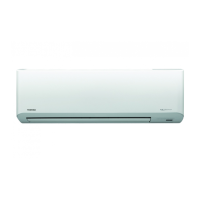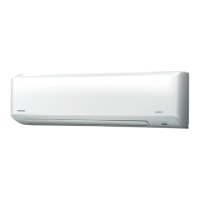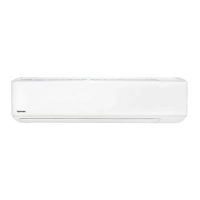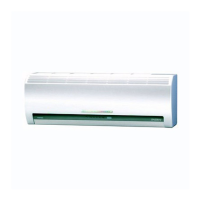Do you have a question about the Toshiba RAS-13N3AV2-E and is the answer not in the manual?
Power supply cord requirements for outdoor unit parts, specifying material and size.
Precautions for R410A refrigerant installation, handling, and material compatibility.
Critical safety measures and warnings regarding electrical shock, fire, and gas leaks during installation.
Table detailing cooling/heating capacity, power, noise, dimensions, weight, and accessories.
Graphs showing current vs. compressor speed for cooling and heating operations.
Graphs illustrating capacity change based on outdoor temperature for cooling and heating.
Precautions for handling R410A refrigerant during installation and servicing.
Guidelines and materials for installing refrigerant piping, including materials and joints.
Procedures for processing piping materials, flare connections, and tightening torques.
Lists tools exclusive to R410A and their interchangeability with R22 tools.
Step-by-step guide on how to recharge refrigerant using equipment and system configuration.
Details on brazing fillers (silver, phosphor bronze) and flux types and their necessity.
Procedures for brazing, including preventing oxidation with nitrogen gas.
Exploded view and dimensional details of the indoor unit and accessories.
Exploded view and dimensional details of the outdoor unit.
Schematic showing electrical connections between indoor and outdoor units and components.
List of electrical components for the indoor unit with their specifications.
List of electrical components for the outdoor unit with their specifications.
Schematic showing the refrigerant flow for specific models.
Schematic showing the refrigerant flow for specific models.
Table showing temperature conditions, pressure, and speed for cooling/heating.
Block diagram showing the indoor unit's control functions and components.
Block diagram illustrating the outdoor unit's control functions and components.
General description of how the air conditioner control system operates.
Introduces various operation modes and details the auto restart function.
Covers basic, cooling/heating, AUTO, and DRY operations.
Details DRY operation and introduces indoor fan motor control.
Explains fan speed control for the indoor unit during cooling operation.
Explains fan speed control for the indoor unit during heating operation.
How capacity is adjusted and current release control protects the inverter.
Protective control based on indoor heat exchanger temperature in cooling/heating.
How defrost operation is performed to remove frost from the outdoor heat exchanger.
Energy-saving ECO mode and temporary operation using the RESET button.
Controls compressor speed based on discharge temp and PMV operation.
Controls the throttle amount of refrigerant using pulse modulation.
Minimizes mold/bacteria growth by drying the indoor unit after operation.
Remote selection and modes like QUIET, COMFORT SLEEP.
Details on Comfort Sleep, One-Touch, and Quiet modes.
Hi-POWER operation and filter maintenance indicator.
Step-by-step guide to set, cancel, and operate the auto restart feature.
Explains button functions and basic operation modes via remote.
Details for One-Touch, Automatic, and Cooling/Heating/Fan Only operations.
Instructions for Dry, Hi-Power, ECO, Temporary, and Timer operations.
How to set preset, auto restart, quiet, and comfort sleep modes via remote.
Explains the various indicators and symbols shown on the remote control display.
Visual guide for installing indoor and outdoor units, including placement and clearances.
Lists and describes optional parts, accessories, and installation items.
Lists all included accessories and installation parts with their part numbers.
Details new tools required for R410A and changes from R22 tools.
Covers installation location, cutting holes, and remote control placement.
Guides for indoor unit wiring and wired remote controller setup.
Details on forming pipes, connecting drain hoses, and related parts.
Specific methods for fixing drain caps and connecting pipes in different configurations.
Covers installation location, refrigerant piping, flaring, and tightening.
Details on flaring dimensions, pipe types, and tightening connections.
Steps for evacuating air from the system using a vacuum pump.
Instructions for power supply connection and wiring between units.
Includes gas leak testing and remote control A-B selection.
How to perform a test run and configure the auto restart function.
General procedures for diagnosing and troubleshooting the unit.
Covers power supply, voltage, and LED indicators for initial diagnosis.
Interprets LED flashing patterns for self-diagnosis of unit status.
How to use the remote controller in service mode to diagnose faults via check codes.
Cautions during servicing and detailed check code explanations for diagnosis.
Table listing check codes, causes, and recommended actions for troubleshooting.
Diagnosing issues when the indoor unit does not operate or has power issues.
Troubleshooting steps if power issues persist after P.C. board replacement.
Diagnosing issues specific to the indoor fan motor not operating.
Procedures for inspecting the indoor fan motor, including resistance checks.
Flowchart for diagnosing issues with the remote control and its operation.
Diagnosing issues related to interconnecting and serial signal wire failures.
Procedures for checking key components like pulse motor valve and sensors.
Summarized diagnosis procedures for the outdoor unit's inverter assembly.
Precautions and procedures for checking the indoor unit's P.C. board.
Detailed checks for the indoor unit's P.C. board, including voltage and component checks.
Diagram of the P.C. board and table of sensor resistance vs. temperature.
Procedures for checking indoor/outdoor unit parts like sensors, motors, and coils.
Methods for checking electrolytic capacitors and converter modules.
How to determine if the outdoor fan motor is functioning correctly.
Step-by-step instructions for removing and replacing the front panel of the indoor unit.
Procedures for removing and replacing the electric parts box assembly.
Steps for replacing the horizontal louver and the evaporator (heat exchanger).
Instructions for removing and replacing the bearing.
Procedures for removing and replacing the fan motor.
Steps for installing and positioning the cross flow fan.
Steps for replacing the microcomputer and related parts.
Steps for detaching and attaching the outdoor unit components.
Procedures for removing and attaching the front cabinet of the outdoor unit.
Steps for replacing the inverter assembly, including discharging.
Procedures for disconnecting and replacing the control board assembly.
Steps for replacing side cabinets and the fan motor.
Procedures for replacing the compressor and reactor.
Steps for replacing the electronic expansion valve coil and fan guard.
Instructions for installing and replacing temperature sensors (TE, TS, TD, TO).
Detailed procedure for replacing temperature sensors for servicing purposes.
Exploded view and list of parts for the indoor unit.
Detailed exploded views of various indoor unit components.
Exploded views of the outdoor unit and its components with part numbers.
Diagrams showing the layout of P.C. boards and associated components.
| Brand | Toshiba |
|---|---|
| Model | RAS-13N3AV2-E |
| Category | Air Conditioner |
| Language | English |











